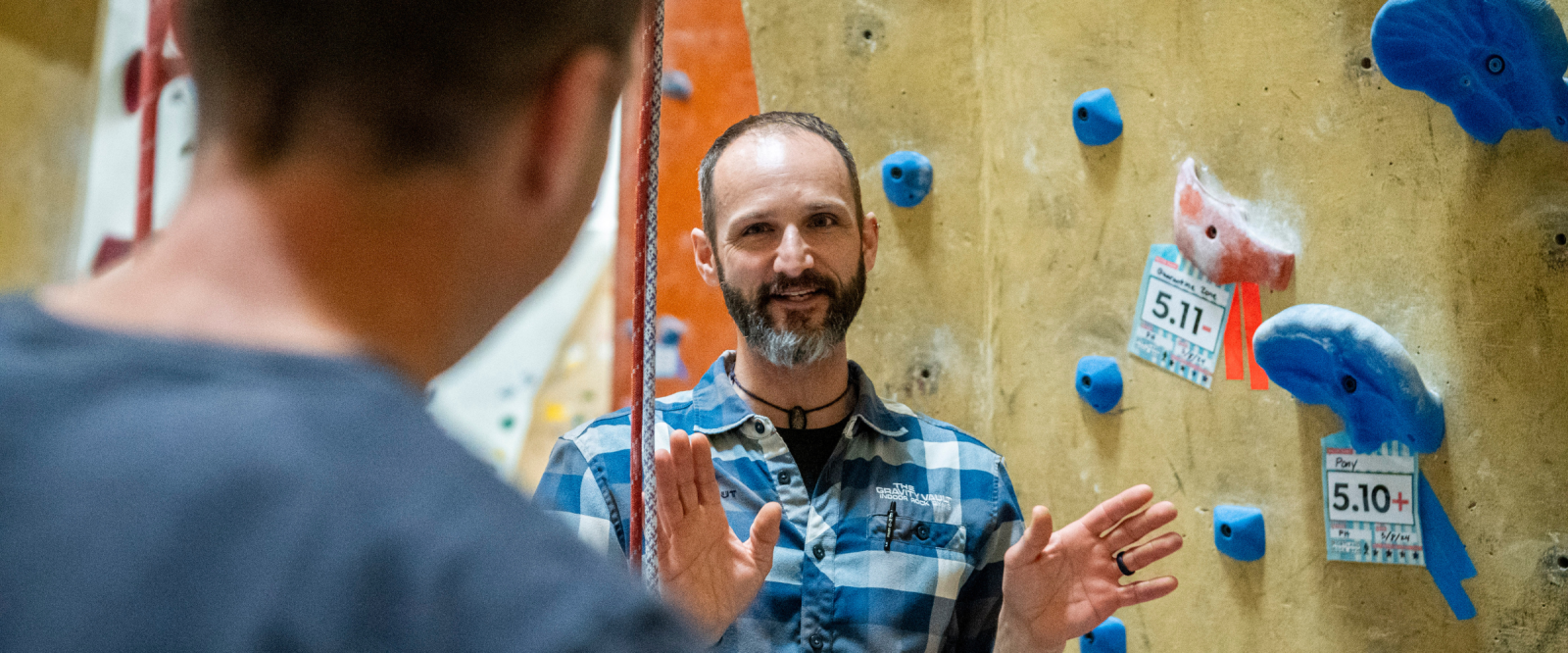Develop Your Elevator Pitch: A Professional Development Exercise
Is it possible to have a career working at an indoor climbing gym? This is a very hot topic in the industry these days. The simple answer is “yes, but…” Yes, there are specific positions within an indoor climbing gym that can be considered a career for many. But for most, working at a climbing gym is merely a job. And what is the difference? Good question.
Article At A Glance |
|
According to the Indeed Editorial Team, a job is “work you perform to earn money to support your basic needs. It can be a full-time or part-time job and might be short-term.” According to the same resource, a career is a “long-term professional journey you may determine based on your passions. It is the path you embark upon to fulfill your professional goals and ambitions.” A career “consists of all the jobs you have worked, regardless of whether they are associated with each other.”
Jobs vs. Careers in the Indoor Climbing Industry
The average indoor climbing gym offers a variety of roles that fit into both categories. Most positions available are and should be, from an economic standpoint, entry-level. Front desk employees, general instructors, youth program coaches, and team coaches–these are all technically entry-level positions.
Even the lowest-tier management positions, like shift leaders or front desk managers, are technically entry-level positions. Routesetting is its own beast, which is why I hesitate to bring that particular position into the mix.
The size of the indoor climbing gym and the company do matter when discussing jobs versus careers. Larger gyms have more programs, more tiers of management, and more positions available. Companies with multiple locations have even more tiers of management and offer more opportunities for professional growth.
Types of Indoor Climbing Gym Employees
From my perspective and experience, there are roughly three different types of climbing gym employees: the industry lifers, those in a transitional phase, and the actively enrolled students. At any point, anyone can shift from one category to another–or even hover between two categories.
The industry lifers are those you can’t ever see leaving the company, or the indoor climbing industry in general. They have an “all-in” mentality and approach to the job. They already view themselves as having a career in the industry. These employees typically throw their name in the hat for every promotional opportunity, they express no desire to leave and often ask to be cross-trained in other areas or departments to gain more skills to further their careers.
These individuals are the greatest unknowns. They are still figuring life out. Some go back to school, while actively employed at the gym. Most eventually leave to pursue different career paths. A few, however, turn into lifers.
This brings us to the actively enrolled students. These employees are essential to most, if not all, indoor climbing gyms. These are the high schoolers and college students we hire. From a management standpoint, scheduling students can be a complete and utter nightmare.
For the most part, they prioritize school over everything else–rightfully so. Ever-changing availability, last-minute call-offs, constant shift swaps–these employees can be a headache. But, there is a flip side. These employees are often hungry–for both hours and money. For most, we are their first job opportunity–and they want to impress us, and they work hard.
Professional Development in Indoor Climbing Gyms
Recruiting management positions can be challenging for indoor climbing gyms. Some gyms might choose to hire managers from outside the company, which has its advantages and disadvantages. Others prefer to promote and grow employees within the company, which also has its advantages and disadvantages. Outside hires may have a lot of experience managing people but might have little to no experience with the sport of rock climbing.
Promoting existing employees can require a lot of coaching and development–but these employees may also possess an in-depth knowledge and understanding of a company’s culture and community.
At the end of the day, culture is everything to me. My managers are my best instructors–these are the people who embody our company’s mission, vision, and values statement. They understand, at a cellular level, how important it is to uphold our risk management standards while providing the highest level of customer service.
They are respected, if not admired, by the community and their coworkers. Not for how hard they climb–but for how much they care, how hard they work, and how much they inspire others around them.
Leadership qualities and experience are important, but those skills can also be developed. Proficiency at the job, reliability and timeliness, accountability and responsibility, working well with others–these are the qualities that I desire most.
Last year, I needed to hire a new front desk manager. Nine employees were interviewed for the spot. During the interview process, I asked each applicant to give me an “Elevator Pitch” for their leadership style.
The result was lackluster. Each employee essentially rattled off the job description and listed all the tasks they thought were important to the job. When asked what makes a great leader, every single person defaulted to the job description.
READ ALSO: ILDP & the Leadership Pipeline
No one could define their leadership style, and everyone lacked the vocabulary necessary to describe what makes a great leader. They couldn’t tell me what would make them a great leader, and they couldn’t tell me what they could bring to the job–just that they knew what the job was, and they knew they could do it.
This process left me flabbergasted. As a natural-born leader and someone who has gone through extensive leadership training, I was at a loss. Or was I? After all, I would be a fraction of the leader I am today without my four decades of coaches, teachers, and mentors.
This inspired me to create a team-building exercise for my management team, which I am calling the “Elevator Pitch Exercise.”
The Elevator Pitch Exercise
Before one can “teach a person to fish” one must first explain the concept of a fish and then explain the act of fishing. But the metaphor doesn’t end there. A person must fillet the fish and then cook the fish before they can eat the fish.
You see, I couldn’t just ask my management team to write and present an Elevator Pitch without giving them the proper tools to do so. And so, I created a 4-Step Worksheet for my managers. Because class participation is pertinent to all my team-building exercises, I had my team present and discuss each step of the way.
Download A Template Based on This Article
Read on to see how to use it. We created a template inspired by Ashley Routson's Elevator Pitch exercise. It works digitally but is best used when printed off.
First order of business, I needed to define the concept of an Elevator Pitch–because this seems to be a lost art that few have learned. I needed everyone to know what our end goal was for this exercise. By the end of this process, the goal was to develop and present a leadership-themed “Elevator Pitch” to the entire team.
First Exercise: Leadership Vocabulary
I presented the team with a list of 50+ positive words commonly used to describe a good leader (with blank spaces to add their own, if needed). I instructed each person to circle a minimum of five and a maximum of ten words that best describe them as a leader. Then, each person shared the terms that they selected with the rest of the team.
Second Exercise: Leadership Styles
Next, I presented the team with a list of six of the most common leadership styles, with definitions for each. We read each definition aloud, as a group, and then I instructed my team to select the best 1-2 leadership styles that they identify with the most. Then, each person shared their leadership style with the group.
Third Exercise: Leadership Roles, Experiences and Accolades
The third exercise was a little more complicated. This task required everyone to think about and list their past and present leadership-related roles, experiences, and accolades. Leadership experience comes in all different shapes and sizes. Leadership roles, experiences, and accolades are key factors that employers and colleges value a lot in applicants. These positions and experiences should be highlighted on resumes, when applicable and appropriate.
I provided my team with a list of common leadership roles, experiences, and accolades–not a comprehensive list, but one that was meant to serve as a jumping-off point. I had each of them create a list of their own, and then we shared it as a group.
Fourth Exercise: The Elevator Pitch
La pièce de résistance! I instructed my team to create an Elevator Pitch about themselves, using all the information we learned in the previous three exercises. The worksheet was written as follows:
Your elevator pitch should explain what kind of leader you are and what leadership qualifications and skills you have. This is your chance to brag a bit. Avoid sounding boastful but do share what you bring to the table. This speech is all about you: who you are, what you do, and what you want to do.
- Start by introducing yourself (i.e.: full name, current title, and company)
- Summarize your leadership style and experience (include the most relevant information such as your education, work experience and/or any key specialties or strengths.)
- Finish with a leadership goal or aspiration you hope to attain in the future.
We went around the room. The first manager chose to stand for the presentation, so the rest followed. Each person spoke with confidence (perhaps a renewed confidence in themselves?).
That day, we all learned a lot about each other–and more importantly, everyone added more tools to their own professional toolboxes.
About the Author
 Ashley Routson is the General Manager of Planet Rock Climbing Gyms in Madison Heights, MI. She is a proud graduate of THE Ohio State University, where she was a member of both the varsity swimming team and varsity rowing team. Ashley came to the indoor climbing industry after nearly two decades of working in the restaurant and craft beer industries. She is also the author of The Beer Wench's Guide to Beer--a comprehensive book detailing all things craft beer. When she isn't pulling on plastic rocks in the gym, Ashley loves moderate trad and sport climbing in the great outdoors.
Ashley Routson is the General Manager of Planet Rock Climbing Gyms in Madison Heights, MI. She is a proud graduate of THE Ohio State University, where she was a member of both the varsity swimming team and varsity rowing team. Ashley came to the indoor climbing industry after nearly two decades of working in the restaurant and craft beer industries. She is also the author of The Beer Wench's Guide to Beer--a comprehensive book detailing all things craft beer. When she isn't pulling on plastic rocks in the gym, Ashley loves moderate trad and sport climbing in the great outdoors.

